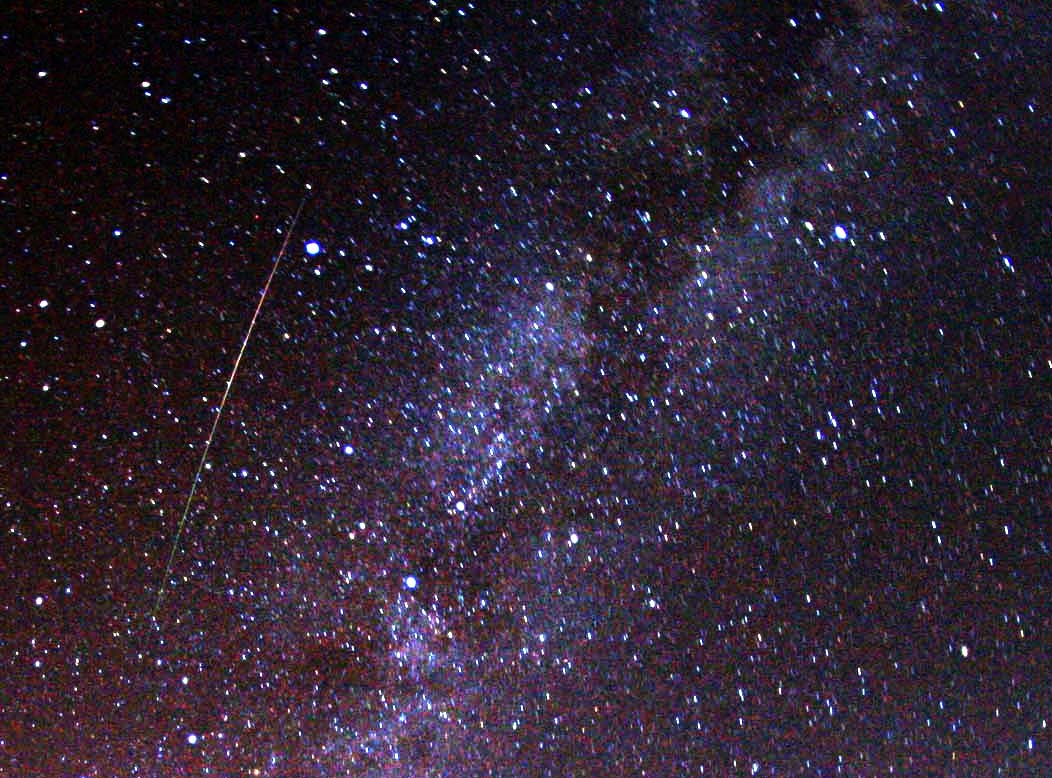The Perseid meteor shower is one of the three best annual showers, the other two being the Orionid shower, which peaks around October 21, and the Geminid shower, which peaks around December 13.
This image shows a multicolored, 2009 Perseid meteor passing just to the left of the Milky Way. Image Credit: Mila Zinkova. Permission granted to display the image here.
Perseid meteors may be visible from July 25 through Aug. 21 with the peak on Thursday, August 11/Friday, August 12. This is a reliable shower, giving consistent rates each year. During its maximum (August 12/13) the meteor hourly rate averages 50 to 68, and sometimes higher. The meteors enter the atmosphere at about 59 km/second and are yellow in color. The Perseid shower occurs each year when Earth passes through the debris trail of Periodic Comet Swift-Tuttle, also called Comet 1862 III, discovered on July 16, 1862 by Lewis Swift and then independently discovered three days later by Horace Tuttle. Perseid meteors will appear to originate from a point in the constellation of Perseus (Right Ascension 03hrs 04min, Declination +58°).
Meteoroid, Meteor and Meteorite
The terms meteor, meteorite and meteoroid are confusing to many, and with good reason. They all refer to the same object, but under different circumstances. Let us first examine the origin of these terms. The word meteor comes from the Greek word meteoron, meaning astronomical phenomenon, or something in the heaven above. This meaning can be understood when we consider that meteorology is the science dealing with the atmosphere and its phenomenon. In its most literal sense, anything that we may see in the sky could be called a meteor, whether it be a thunder cloud, a supernova or a UFO. For the purpose of sanity, we shall confine its usage to relatively small bodies which drift through space, fall into Earth's atmosphere, and sometimes reach the ground.
A meteoroid is a relatively small object, smaller than an asteroid or minor planet, drifting through space in orbit around the Sun. Bits smaller than grains of sand are sometimes called micrometeoroids. A meteor is the effect produced as the meteoroid plows into our atmosphere and streaks across the sky. A glowing trail, sometimes called a train, is created to mark the path of the meteoroid as it falls. When a meteoroid, or a fragment of it, reaches the ground, it is called a meteorite. These may be found, dug up, held, and examined. The only way to hold a meteoroid is either to float with it in space or fall with it through the sky!
Many meteoroids are the size of salt or sugar grains and most are no bigger than grains of rice, though some can be the size of giant boulders weighing several tons. As the meteoroids enter Earth's atmosphere, at speeds ranging from 11 to 72 kilometers (7 to 45 miles) per second, their surfaces collide with the atoms and molecules of the atmosphere. These collisions break loose material from their surface and also break up the atoms and molecules of both the meteoric material and the atmosphere into charged particles. The ionized atoms are excited and begin to glow 50 to 75 miles up. These glowing tubes that the meteoroids create as they pass are called trails or trains. Some meteor trails are short, and some are long -- spanning 20 degrees or more across the sky. Most trails are white, blue, or yellow, but some can be red or even green. These ionized trails also show as reflections on radar. Astronomers have used radar since 1945 to record the rate of meteors that fall. Radar observations allow astronomers to track meteor showers that occur during the daytime as well.
Perseid Visibility Growing
The Perseid peak is still days away, but observers around the globe are already seeing hourly rates of 10 or more, with occasional fireballs. The early reports could be indicating that the peak on Thursday night / Friday morning will be quite a show.
-

No comments:
Post a Comment